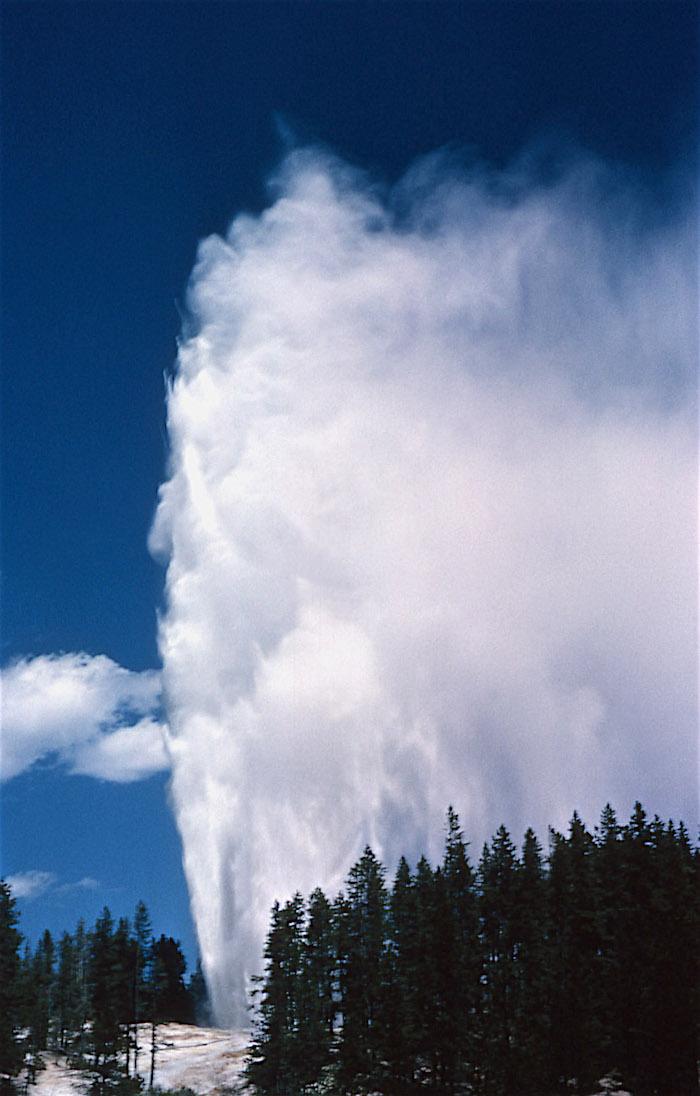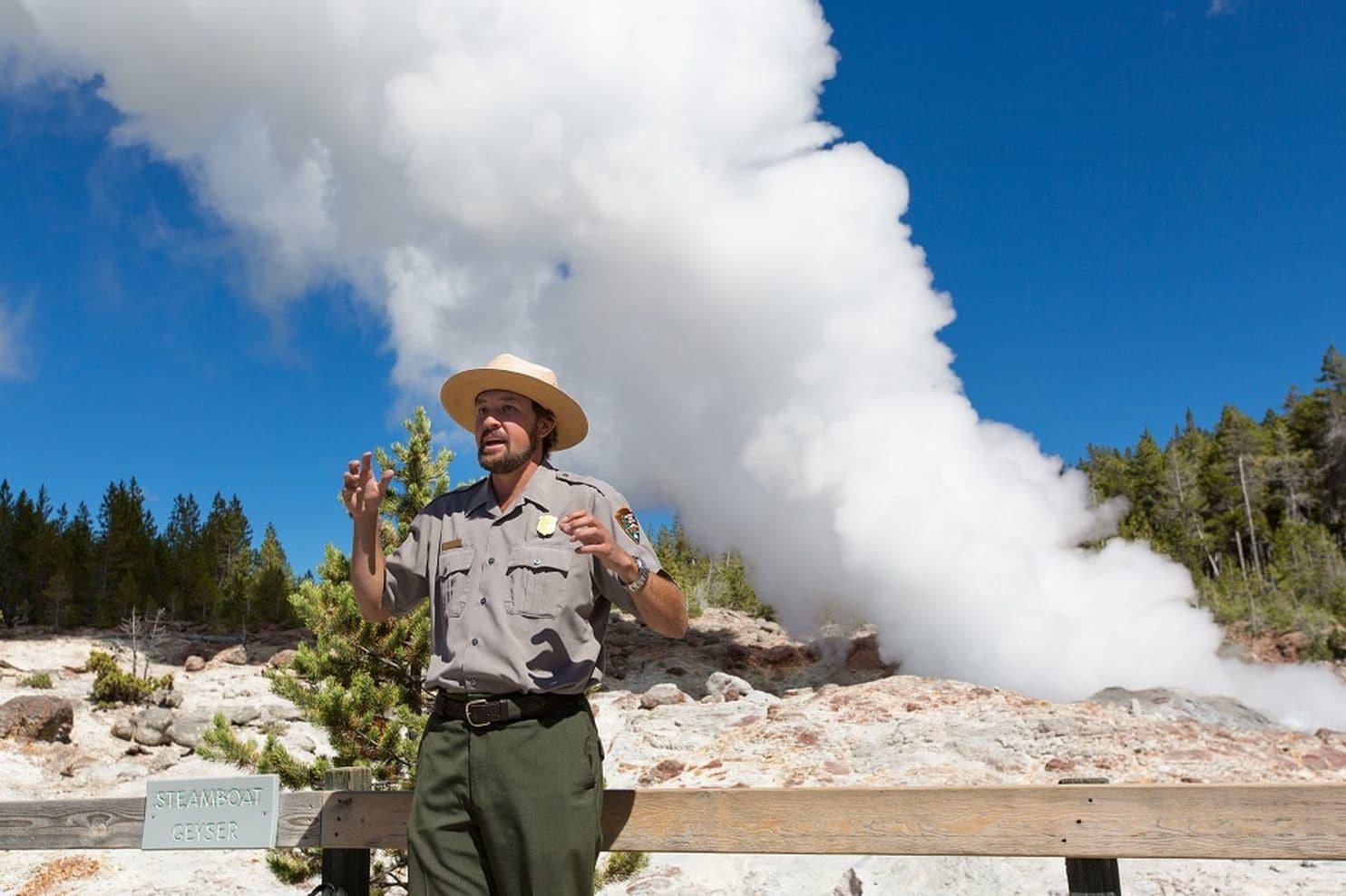
Eruption of Steamboat Geyser in Yellowstone National Park in 1963/NPS, Robert J Lang & William Dick
It's not hard to think of Yellowstone National Park as a living, breathing entity. You have the park's wildlife, of course, and the streams running and jumping downhill, and the trees that shed their leaves each fall and replace them each spring. And then there are the geothermal features, with all their gurgling, boiling, erupting, and fuming.
And like all living entities, the geysers and mudpots and hot springs and fumaroles ebb and flow, and fume and spit, gush and shower, and rise and fall. Such changes in patterns at times are suggestive of ... nothing.
And that seems to be the case with Steamboat, the world's largest active geyser with a soaring 300-to-400-foot spray of hot water accompanying some of its most vociferous eruptions. While Steamboat, located in the park's Norris Geyser Basin, has erupted three times this year, a relative gangbuster of activity for a geyser that can go years without erupting, the activity very possibly is indicative of nothing special.
“There really isn’t much to report on. The reason it’s getting attention is because Steambaot is famously known and it doesn’t erupt that often," replied Dr. Michael Poland, the USGS scientist-in-charge of the Yellowstone Volcano Observatory, when asked about the media attention given to Steamboat recently. "But it does go through these time periods where it does erupt frequently. It erupted five times in '02 and '03, and it erupted dozens of times between '82 and '84. And it was incredibly active in the '60s. So geysers go through these cycles, some of them anyway, where they’re more active or less active."
So far this year Steamboat, which was given that name by members of the 1878 Hayden expedition for its roaring sound thought similar to that of "an old style paddle wheel steamboat," has come to life on March 15, April 19, and April 27. But this year's eruptions have been less vigorous than Steamboat's signature blasts, which adds somewhat to the keen media interest, with some outlets proclaiming that scientists were "puzzled," "unsure," and unable to "explain" its behavior.
Dr. Poland didn't seem overly puzzled, but is interested in seeing what the geyser does in the weeks and months ahead.
"It’s interesting in that perhaps we’re entering a time period where Steamboat is becoming more active. Maybe it does indicate something about the general plumbing in the Norris area, and we’ll see changes," speculated the geophysicist who also has worked at the USGS's Hawaii Volcano Observatory and the Cascades Volcano Observatory. "That’s a possibility. Or it’s just a random geyser activity.”
The sporadically active geyser has now erupted 3 times in the past 6 weeks. Based on seismic data, all three eruptions have been smaller than the major events of 2013 and 2014, but these 2018 eruptions each still discharged about 10 times more water than a typical eruption of Old Faithful. Although a bit unusual, such frequent eruptions are not unique. Steamboat behaves randomly. -- Yellowstone Volcano Observatory
This weekend Dr. Poland and colleagues are gathered in Yellowstone for the biennial Yellowstone Volcano Observatory coordination meeting. At the same time, additional seismic monitors are being installed near Steamboat, which officially is known as New Crater Geyser but also has been called Fissure Geyser, Double Crater Geyser, Nobel Geyser, and Tippecanoe Geyser.
“If Steamboat continues to erupt, then perhaps the (underground geothermal plumbing) system has changed for some reason, and maybe that’s making an argument that we should be going and trying to learn a little bit more about it because we’re going to see some thing," he said last week. "There is a small deployment of sensors that is going to be carried out just in case. They’re going to install a couple of seismic sensors around the geyser. Just to have a little bit of extra seismic coverage there in case it does erupt again."
To a layman, additional seismic monitoring data might not seem like much. But according to Dr. Poland, the data can be filtered in many ways and tell many stories.
"It’s not just about locating earthquakes," he said of the monitors. "It’s about looking at the seismic waves. And so, for example, you might filter the seismic waves to look at the specific frequencies and see how they get excited and how they correlate with various phases of the eruption. You can correlate different parts of the waves between seismic stations and see when they arrive, or there may be subtle differences in the way the seismometers are excited by different types of energy. And that can tell you something about the plumbing system.
“Is there a cavity where boiling water accumulates below Steamboat? Or is it a more diffuse network?" the geophysicist went on. "That might actually be useful in telling us something about why Steamboat is different from a place like Old Faithful. And then we can start to develop a model for geysers like Steamboat that may be active for a few weeks, or months, and then go to sleep for years."
If it does erupt in the near term, "there would be some interesting data coming out of this deployment. Maybe it argues for something a little bit more comprehensive. Especially because if it erupts again, perhaps we are getting in a pattern where it’s going to be going off every few weeks," said Dr. Poland. "Which would be wonderful, right? I mean, I would love to see it go and to know that so many more people this summer could have the potential to take in the spectacle. That would be fantastic.”
In his Yellowstone Place Names, park historian Lee H. Whittlesey said history shows that Steamboat can be extremely unpredictable. And his research shows that this year's eruptions really aren't unusual.
P.W. Norris claimed that the geyser "burst forth" on August 11, 1878, and that it had two types of eruptions: one 30 feet high every half hour and one 100 feet high every 6 to 7 days. A.C. Peale also thought in 1878 that the geyser was newly formed and named it "Steamboat Vent."
Steamboat Geyser had numerous powerful eruptions in 1881 to at least 100 feet. It is likely that these "heavy" eruptions continued during 1882 and 1883, combining with Steamboat's "normal" smaller eruptions from 5 to 30 feet high. The geyser also had large (major phase) eruptions in 1888, 1889 (probable), 1890, 1891, 1892 (probable), 1894, 1902, and 1911. These eruptions are estimated to have attained heights of from 100 to 350 feet. After 1911, Steamboat did not erupt again in major phase for 50 years.

A ranger in 2014 explained the eruption process of Steamboat Geyser, then in steam phase, to onlookers/NPS
What hasn't seemed to garner as much attention as they have in the past are the "swarms" of hundreds of earthquakes that recently have shaken Yellowstone, according to the observatory.
During April 2018, the University of Utah Seismograph Stations, responsible for the operation and analysis of the Yellowstone Seismic Network, located 200 earthquakes in the Yellowstone National Park region. The largest event was a minor earthquake of magnitude 2.7 that occurred about seven miles north of West Yellowstone, MT, on April 07 at 03:40 AM MDT. No earthquakes were reported "felt" in the Yellowstone region in April.
A swarm of 115 earthquakes was located about 8 miles east of West Thumb, WY, during April 11-16. The largest swarm earthquake, a magnitude 2.4 event, occurred on April 11 at 10:06 AM MDT.
Activity continued in the area of last summer's Maple Creek swarm, with 48 April earthquakes. This persistent seismicity includes the largest event of the month (the aforementioned magnitude 2.7 earthquake on April 07).
“That’s pretty normal," said Dr. Poland. "Something like half of all the earthquakes in Yellowstone are part of these swarms. It’s kind of a silly thing to say, but Yellowstone is a swarmy place. It just seems to have these little knots of earthquakes that light up and stop and light up and stop.”
Back in January 2010 much attention was focused on an ongoing swarm of quakes that numbered more than 1,200, events that likely were the result of slips on pre-existing faults and dubbed tectonic earthquakes and not thought to be caused by underground movement of magma.
Returning to the media interest in Steamboat's recent activity, the geophysicist said the 2005 movie, Supervolcano, which revolved around a cataclysmic eruption of the Yellowstone caldera, still seems to feed media interest, "this whole idea that it’s a supervolcano that’s going to kill you because the BBC and the Discovery Channel made a movie about it," he said. "It’s quite funny, the number of comments I see that, ‘but in the movie this is what happened.’ 'Yes, but you do understand that it was a movie, right?'”



Add comment